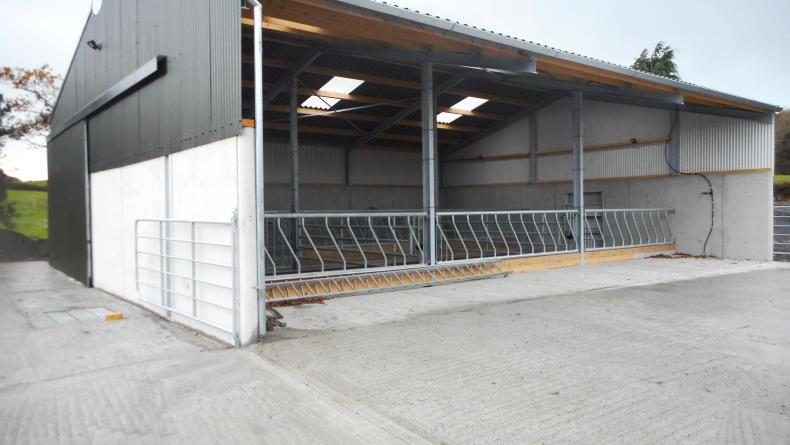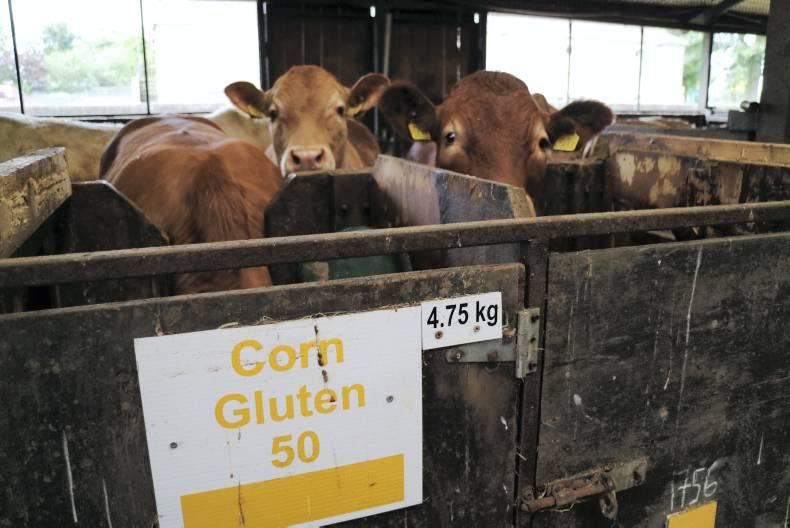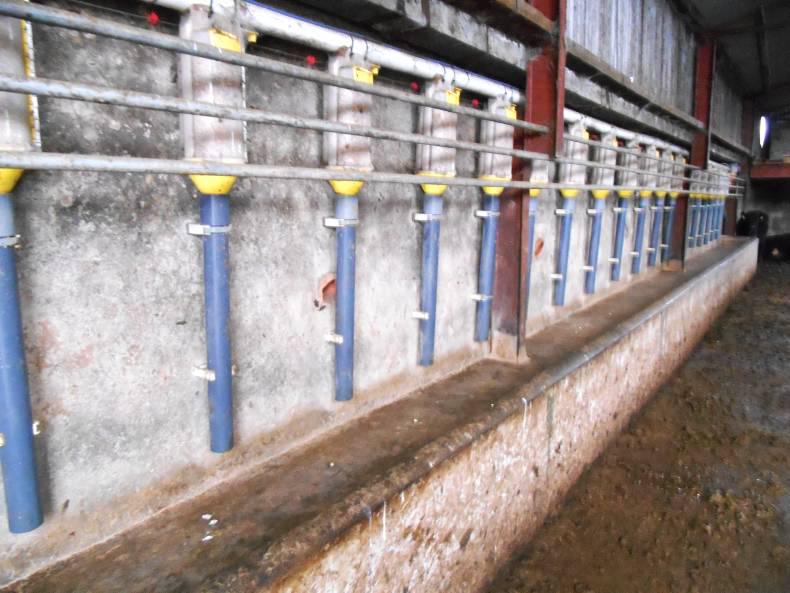It is always nice to feature a smaller-scale suckler shed on these pages when possible. For most Irish farmers it is more in line with a typical development that would take place on the farm. The shed featured here is mainly designed to house suckler cows and their calves but there is scope to convert the shed so that it would be suitable for finishing beef cattle if needs be. The Co Clare farmer who built the shed said he needed it for two main reasons:
1. To increase slurry storage capacity to comply with nitrates regulations. 2. More space for housing cows with good calving facilities to make life easier.The shed
The shed is just three standard bays long but is very compact; it is built by Declan Fennell Contracting Ltd of Cooraclare, Co Clare. It is 37.5ft wide and 14ft high at the eaves. An 8ft roof overhang at the front of the shed helps keep fodder dry and the side walls are extended to reduce drafts in the shed. All the walls are constructed from mass concrete. The roof cladding is fibre cement. According to Declan Fennell, the use of fibre cement comes with the bonus of less chance of condensation and leaks. The feed barriers and the slat mats were sourced from Condon Engineering in Louth.

Inside, it is kitted out with rubber mats. The farmer wanted mats because he believes it is important to provide cows with a certain level of comfort and hopes the mats will reduce the chances of cows getting hurts. The slatted area is divided into three pens but the dividing gates are easily removed if the need arises to increase pen size. The farmer opted for nose drinkers because he felt they were easy to clean and cows are always getting fresh water.
There are feed barriers at the back of the slatted pens. These feed barriers may never be used but it opens up the possibility of utilising the shed for finishing cattle – increasing the number of feeding spaces available per slatted pen. The shed in its current state accommodates nine Charolais suckler cows per pen (27 cows in total) and their calves.
Declan Fennell manufactured the 14ft 5in CE mark gang slats that are placed over the 9ft deep slurry tank. Both agitation points are outside at the gable ends of the shed.


The calf creep/calving area are situated at the back of the shed. This is a dry bedded area and is bedded with straw at housing. The creep gates enables calves to make their way to this area to get access to concentrates without cows or just to lie down in clean bedding. The farmer also made sure to erect to calving gates here so if a cow is close two calving he will separate her from the main bunch and leave her in the straw bedded area. The calving gates are available if the cow needs assistance. A nice safety feature the farmer added to the shed was the 3ft wide walkway at the back of the calving/creep pens.
“With the walkway I can check a cow near calving without having to enter a pen. This is safer and is also useful before bedtime when you just want to check a cow without having to throw on the wellies again,” the farmer explained. He said that he could also hang troughs off the back gates and feed calves from this walkway.


At one end of the shed there is a small door (picture five) off the slatted area. A homemade creep gate in front of this door will enable calves to go outside in the spring time to graze grass. The farmer said if there is a large number of cows with calves a foot he will take away the dividing gates in the slatted pens so more calves can go outside.
On the other gable end there is a big sliding door (picture six) measuring 15ft x 12ft. This is present so a tractor can be used to clean out the creep area. The door can be left open to allow more air into the shed if needs be and a gate at the entrance to the creep area prevents livestock leaving the shed.
Cost:
The shed itself including the 9ft concrete tank cost €49,000 including VAT. This cost also included three extra loads of concrete to match in with the existing yard. The rubber mats for the three slatted pens cost €4,100 including VAT and the wiring and lights for the shed cost €1,350 including 13.5% VAT. The farmer will get the VAT back. It is the farmer’s intention to put cameras in the shed in the next year or two so cows can be monitored at night time from the house.
It is always nice to feature a smaller-scale suckler shed on these pages when possible. For most Irish farmers it is more in line with a typical development that would take place on the farm. The shed featured here is mainly designed to house suckler cows and their calves but there is scope to convert the shed so that it would be suitable for finishing beef cattle if needs be. The Co Clare farmer who built the shed said he needed it for two main reasons:
1. To increase slurry storage capacity to comply with nitrates regulations. 2. More space for housing cows with good calving facilities to make life easier.The shed
The shed is just three standard bays long but is very compact; it is built by Declan Fennell Contracting Ltd of Cooraclare, Co Clare. It is 37.5ft wide and 14ft high at the eaves. An 8ft roof overhang at the front of the shed helps keep fodder dry and the side walls are extended to reduce drafts in the shed. All the walls are constructed from mass concrete. The roof cladding is fibre cement. According to Declan Fennell, the use of fibre cement comes with the bonus of less chance of condensation and leaks. The feed barriers and the slat mats were sourced from Condon Engineering in Louth.

Inside, it is kitted out with rubber mats. The farmer wanted mats because he believes it is important to provide cows with a certain level of comfort and hopes the mats will reduce the chances of cows getting hurts. The slatted area is divided into three pens but the dividing gates are easily removed if the need arises to increase pen size. The farmer opted for nose drinkers because he felt they were easy to clean and cows are always getting fresh water.
There are feed barriers at the back of the slatted pens. These feed barriers may never be used but it opens up the possibility of utilising the shed for finishing cattle – increasing the number of feeding spaces available per slatted pen. The shed in its current state accommodates nine Charolais suckler cows per pen (27 cows in total) and their calves.
Declan Fennell manufactured the 14ft 5in CE mark gang slats that are placed over the 9ft deep slurry tank. Both agitation points are outside at the gable ends of the shed.


The calf creep/calving area are situated at the back of the shed. This is a dry bedded area and is bedded with straw at housing. The creep gates enables calves to make their way to this area to get access to concentrates without cows or just to lie down in clean bedding. The farmer also made sure to erect to calving gates here so if a cow is close two calving he will separate her from the main bunch and leave her in the straw bedded area. The calving gates are available if the cow needs assistance. A nice safety feature the farmer added to the shed was the 3ft wide walkway at the back of the calving/creep pens.
“With the walkway I can check a cow near calving without having to enter a pen. This is safer and is also useful before bedtime when you just want to check a cow without having to throw on the wellies again,” the farmer explained. He said that he could also hang troughs off the back gates and feed calves from this walkway.


At one end of the shed there is a small door (picture five) off the slatted area. A homemade creep gate in front of this door will enable calves to go outside in the spring time to graze grass. The farmer said if there is a large number of cows with calves a foot he will take away the dividing gates in the slatted pens so more calves can go outside.
On the other gable end there is a big sliding door (picture six) measuring 15ft x 12ft. This is present so a tractor can be used to clean out the creep area. The door can be left open to allow more air into the shed if needs be and a gate at the entrance to the creep area prevents livestock leaving the shed.
Cost:
The shed itself including the 9ft concrete tank cost €49,000 including VAT. This cost also included three extra loads of concrete to match in with the existing yard. The rubber mats for the three slatted pens cost €4,100 including VAT and the wiring and lights for the shed cost €1,350 including 13.5% VAT. The farmer will get the VAT back. It is the farmer’s intention to put cameras in the shed in the next year or two so cows can be monitored at night time from the house.




















SHARING OPTIONS